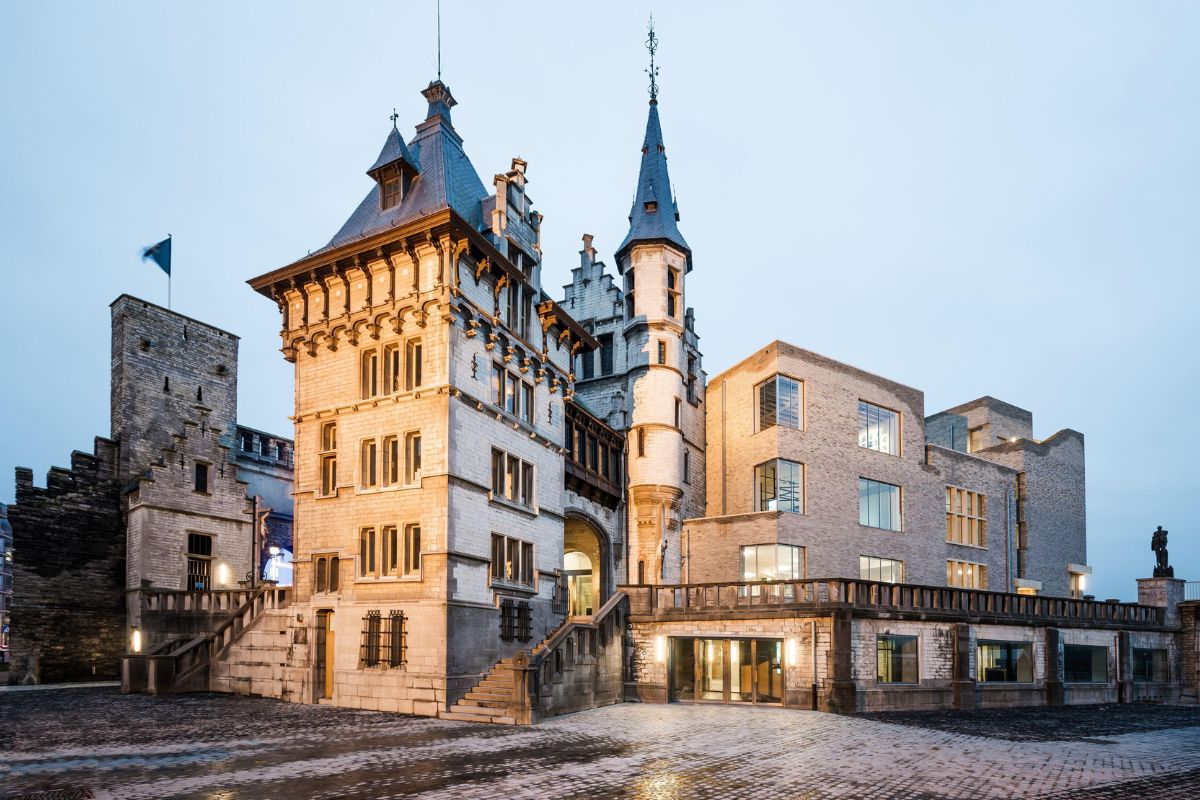Steen Castle
Steen Castle, locally known as Het Steen, stands as Antwerp’s oldest surviving building. Originally built between 1200 and 1225, this medieval fortress guarded the historic Scheldt River. Serving as part of the Dukes of Brabant’s defensive complex, it has witnessed centuries of Antwerp’s evolution. Today, it holds both cultural and architectural importance, bridging Antwerp’s medieval past with its vibrant present. Throughout its history, the castle performed varied roles—from a military stronghold and prison to a museum and modern visitor centre. This layered heritage offers you a unique window into Antwerp’s urban story.
Location of Steen Castle
Het Steen sits on the right bank of the Scheldt River in Antwerp’s old city centre. You can reach it easily on foot from the Grote Markt or from the quay lined with historic shipping facilities. Furthermore, nearby you will find the Lange Wapper statue, a depiction of an infamous local giant, along with a fragment of the original fortified quay. The castle overlooks the river, once the artery of Antwerp’s trade and defense. It stands amid quays, urban parks, and city streets that once connected medieval port activity with the heart of the city.

History of Steen Castle
The people of Antwerp first built wooden and earthen defenses on the De Werf peninsula in the 9th century. During early medieval struggles against Viking raids, they replaced these with stone fortifications. Between 1200 and 1225, the Dukes of Brabant oversaw the construction of a stone gatehouse as part of a larger fortress. This structure secured the western approach to the city from across the Scheldt.
In around 1520, Holy Roman Emperor Charles V had the gatehouse refurbished with new sandstone features by architects Keldermans and De Waghemakere. The renovation enhanced its defensive capabilities and gave it the name ‘s-Heeren Steen, later shortened to Het Steen. From 1303 until 1827, the castle also functioned as a prison. The prison’s grim legacy is still found near the entrance, marked by a cross where prisoners said their last prayers.
In the 19th century, much of the fortress was demolished to straighten the Scheldt’s quays, reducing the structure to part of the original complex. In 1842 the city acquired the remaining structure.
From 1862 to 2008, Het Steen served as housing for archaeological collections and later for the national maritime museum. In 2011, those maritime collections moved to the Museum aan de Stroom. The entrance arch still bears a bas-relief of Semini, a pagan fertility deity whose statue once showed an explicit phallus removed by Jesuits in the 16th or 17th centuries. Just outside, the imposing statue of the folklore giant Lange Wapper presides over the quay.
In October 2021, a major renovation converted Het Steen into a modern visitor centre and cruise terminal. A contemporary concrete extension blends with medieval stone, offering interactive exhibits on Antwerp’s history.

Current Status
Today, Het Steen functions as a vibrant visitor hub. It houses the Antwerp Visitor Centre, complete with city maps, tourist information, multilingual staff, and a selection of souvenirs and local products. On the upper floor, The Antwerp Story interactive exhibition showcases the city’s development through multimedia installations and engaging displays. You can walk through eleven rooms with thematic historical contexts—including medieval times, maritime trade, art, and urban growth.
From the tower, a roof terrace offers panoramic views over the Scheldt, the port, and the city. It’s a popular viewpoint for cruises docking or departing. Accessibility features are well-considered; lifts and ramps make most areas available for wheelchair users, though a historical chapel remains inaccessible. The site hosts guided tours and is sometimes used for temporary exhibits. It also acts as a gateway for walking tours of Antwerp’s historic core and riverfront. The castle’s offices support cruise arrivals and act as a starting point for tourists exploring the city.
Management is overseen by the City of Antwerp, in collaboration with heritage groups, including Komitee Semini in Ere, which celebrates the Semini relief.
Admission
Community features
Castle features
Video
Location
Official website
Featured listings














